Strength, Stiffness, and Microstructure of Stabilized Marine Clay-Crushed Limestone Waste Blends: Insight on Characterization through Porosity-to-Cement Index
Abstract
1. Introduction
2. Experimental Program
2.1. Materials
2.2. Specimens Molding and Preparation
2.3. UCS and Stiffness Program
2.4. Microstructural Analysis
2.5. Statistical Analysis
3. Results and Discussions
3.1. Effects of Porosity/Cement Index and Curing Periods on Strength for Soil−CLW−Cement Blends
3.2. Effects of Porosity/Cement Index and Curing Periods on Stiffness for Soil−CLW−Cement Blends
3.3. Effects of Porosity/Cement Index and Curing Periods on Stiffness for Soil−CLW−Cement Blends
3.4. Microstructure and Microanalysis of Compacted Blends
3.5. Statistical Analysis
4. Conclusions
Author Contributions
Funding
Institutional Review Board Statement
Informed Consent Statement
Data Availability Statement
Acknowledgments
Conflicts of Interest
References
- Centi, G.; Perathoner, S. The Chemical Engineering Aspects of CO2 Capture, Combined with Its Utilisation. Curr. Opin. Chem. Eng. 2023, 39, 100879. [Google Scholar] [CrossRef]
- Meng, D.; Unluer, C.; Yang, E.H.; Qian, S. Recent Advances in Magnesium-Based Materials: CO2 Sequestration and Utilization, Mechanical Properties and Environmental Impact. Cem. Concr. Compos. 2023, 138, 104983. [Google Scholar] [CrossRef]
- Rana, A.; Kalla, P.; Csetenyi, L.J. Recycling of Dimension Limestone Industry Waste in Concrete. Int. J. Min. Reclam. Env. 2017, 31, 231–250. [Google Scholar] [CrossRef]
- Cavaleri, L.; Paul Borg, R.; Mantia, F.P.L.; Liguori, V. Quarry Limestone Dust as Fine Aggregate for Concrete. In Proceedings of the IOP Conference Series: Materials Science and Engineering, Valleta, Malta, 10 April 2018; Volume 442. [Google Scholar]
- Cabalar, A.F.; Alosman, S.O. Influence of Rock Powder on the Behaviour of an Organic Soil. Bull. Eng. Geol. Environ. 2021, 80, 8665–8676. [Google Scholar] [CrossRef]
- Abdelkader, H.A.M.; Ahmed, A.S.A.; Hussein, M.M.A.; Ye, H.; Zhang, J. An Experimental Study on Geotechnical Properties and Micro-Structure of Expansive Soil Stabilized with Waste Granite Dust. Sustainability 2022, 14, 6218. [Google Scholar] [CrossRef]
- Blayi, R.A.; Sherwani, A.F.H.; Mahmod, F.H.R.; Ibrahim, H.H. Influence of Rock Powder on the Geotechnical Behaviour of Expansive Soil. Int. J. Geosynth. Ground Eng. 2021, 7, 14. [Google Scholar] [CrossRef]
- Consoli, N.C.; Vogt, J.C.; Silva, J.P.S.; Chaves, H.M.; Scheuermann Filho, H.C.; Moreira, E.B.; Lotero, A. Behaviour of Compacted Filtered Iron Ore Tailings–Portland Cement Blends: New Brazilian Trend for Tailings Disposal by Stacking. Appl. Sci. 2022, 12, 836. [Google Scholar] [CrossRef]
- Pasche, E.; Bruschi, G.J.; Specht, L.P.; Aragão, F.T.S.; Consoli, N.C. Fiber-Reinforcement Effect on the Mechanical Behavior of Reclaimed Asphalt Pavement–Powdered Rock–Portland Cement Mixtures. Transp. Eng. 2022, 9, 100121. [Google Scholar] [CrossRef]
- Hoch, B.Z.; Diambra, A.; Ibraim, E.; Festugato, L.; Consoli, N.C. Strength and Stiffness of Compacted Chalk Putty–Cement Blends. Acta Geotech. 2022, 17, 2955–2969. [Google Scholar] [CrossRef]
- Menger, E.S.; Da Silva, A.; Festugato, L. Mechanical Behavior of a Fiber Reinforced Reclaimed Asphalt Pavement Sand-Cement Blend. Geosynth. Int. 2022, 29, 520–533. [Google Scholar] [CrossRef]
- De Jesús Arrieta Baldovino, J.; dos Santos Izzo, R.L.; Ekinci, A. Strength, Durability, and Microstructure of Lime Production Residue Glass Powder Binder-Based Geomaterial. Acta Geotech. 2022, 18, 1593–1606. [Google Scholar] [CrossRef]
- Scheuermann Filho, H.C.; Dias Miguel, G.; Cesar Consoli, N. Porosity/Cement Index over a Wide Range of Porosities and Cement Contents. J. Mater. Civ. Eng. 2022, 34, 06021011. [Google Scholar] [CrossRef]
- Da Silva, A.; Festugato, L.; Daronco, J.V.L.; da Silva Menger, E. Mechanical Response of a Sand, Reclaimed-Asphalt Pavement, and Portland Cement Mixture. J. Mater. Civ. Eng. 2022, 34, 04022213. [Google Scholar] [CrossRef]
- Consoli, N.C.; Scheuermann, H.C.; Godoy, V.B.; Rosenbach, C.M.D.C.; Carraro, J.J.A.H. Durability of RAP-Industrial Waste Mixtures Under Severe Climate Conditions. Soils Rocks 2018, 41, 149–156. [Google Scholar] [CrossRef]
- Acuña, C.; Betancur, J.; Baldovino, J.A.; Barboza, G.; Saba, M. Analysis of Dispersivity in Marine Clays of Cartagena de Indias, Colombia. Geoscience 2023, 13, 162. [Google Scholar] [CrossRef]
- BSI BS ISO 13320; Particle Size Analysis—Laser Diffraction Methods. British Standards Institution: London, UK, 2009.
- ASTM 4318; Standard Test Methods for Liquid Limit, Plastic Limit and Plasticity Index of Soils. ASTM International: West Conshohocken, PA, USA, 2010.
- ASTM D854-14; Standard Test Methods for Specific Gravity of Soil Solids by Water Pycnometer. ASTM International: West Conshohocken, PA, USA, 2014.
- ASTM D698-12; ASTM Test Method for Laboratory Compaction Characteristics of Soils Using Standard Effort (12.400 Ft-Lbf/Ft 3 (600 KN-m/m3)). ASTM International: West Conshohocken, PA, USA, 2012.
- ASTM D2487-17; Standard Practice for Classification of Soils for Engineering Purposes (Unified Soil Classification System). ASTM International: West Conshohocken, PA, USA, 2011; pp. 1–16. [CrossRef]
- ASTM C150-07; Standard Specification for Portland Cement. ASTM International: West Conshohocken, PA, USA, 2019.
- ASTM D1633-17; Standard Test Methods for Compressive Strength of Molded Soil-Cement Cylinders. ASTM International: West Conshohocken, PA, USA, 2007.
- De Jesús Arrieta Baldovino, J.; dos Santos Izzo, R.L.; Rose, J.L. Effects of Freeze–Thaw Cycles and Porosity/Cement Index on Durability, Strength and Capillary Rise of a Stabilized Silty Soil Under Optimal Compaction Conditions. Geotech. Geol. Eng. 2021, 39, 481–498. [Google Scholar] [CrossRef]
- Consoli, N.C.; Párraga Morales, D.; Saldanha, R.B. A New Approach for Stabilization of Lateritic Soil with Portland Cement and Sand: Strength and Durability. Acta Geotech. 2021, 16, 1473–1486. [Google Scholar] [CrossRef]
- Consoli, N.C.; da Silva Lopez JR, L.; Consoli, B.S.; Festugato, L. Mohr–Coulomb Failure Envelopes of Lime-Treated Soils. Géotechnique 2014, 64, 165–170. [Google Scholar] [CrossRef]
- Consoli, N.C.; Festugato, L.; Consoli, B.S.; da Silva Lopes, L. Assessing Failure Envelopes of Soil–Fly Ash–Lime Blends. J. Mater. Civ. Eng. 2015, 27, 04014174. [Google Scholar] [CrossRef]
- Saldanha, R.B.; Consoli, N.C. Compressibility, Durability and Strength of Coal Fly Ash–Carbide Lime–Sodium Chloride Blends. Int. J. Geosynth. Ground Eng. 2021, 7, 42. [Google Scholar] [CrossRef]
- Baldovino, J.d.J.A.; Izzo, R.L.d.S.; Pereira, M.D.; Rocha, E.V.d.G.; Rose, J.L.; Bordignon, V.R. Closure to “Equations Controlling Tensile and Compressive Strength Ratio of Sedimentary Soil–Cement Mixtures under Optimal Compaction Conditions” by Jair de Jesús Arrieta Baldovino, Ronaldo Luis Dos Santos Izzo, Mirian Dayane Pereira, Eduardo Vieira de Goes Rocha, Juliana Lundgren Rose, and Vitor Reinaldo Bordignon. J. Mater. Civ. Eng. 2021, 33, 07021002. [Google Scholar] [CrossRef]
- ASTM C597-16; Standard Test Method for Pulse Velocity Through Concrete. ASTM International: West Conshohocken, PA, USA, 2016.
- Filho, H.C.S.; Dias Miguel, G.; Cesar Consoli, N. Durability Response of a Cemented Clayey Sand over a Wide Range of Porosities and Cement Contents. Clean. Mater. 2022, 5, 100117. [Google Scholar] [CrossRef]
- Diambra, A.; Ibraim, E.; Peccin, A.; Consoli, N.C.; Festugato, L. Theoretical Derivation of Artificially Cemented Granular Soil Strength. J. Geotech. Geoenvironmental Eng. 2017, 143, 04017003. [Google Scholar] [CrossRef]
- Pereira dos Santos, C.; Bruschi, G.J.; Mattos, J.R.G.; Consoli, N.C. Stabilization of Gold Mining Tailings with Alkali-Activated Carbide Lime and Sugarcane Bagasse Ash. Transp. Geotech. 2022, 32, 100704. [Google Scholar] [CrossRef]
- Consoli, N.C.; Scheuermann Filho, H.C.; Leon, H.B.; da Silva Carretta, M.; Corte, M.B.; Cordeiro, R.E.; Caballero, R.D.; Lourenço, D.E. General Relationships Controlling Loss of Mass, Stiffness and Strength of Sustainable Binders Amended Sand. Transp. Geotech. 2021, 27, 100473. [Google Scholar] [CrossRef]
- Baldovino, J.A.; Izzo, R.; Ekinci, A. Strength Relationship Equation for Artificially Stabilized Rammed Sedimentary Soils. Buildings 2022, 12, 1433. [Google Scholar] [CrossRef]
- Consoli, N.C.; Quiñonez, R.A.; González, L.E.; López, R.A.; Quiñónez, R.A.; González, L.E.; López, R.A.; Quiñonez, R.A.; González, L.E.; López, R.A.; et al. Influence of Molding Moisture Content and Porosity/Cement Index on Stiffness, Strength, and Failure Envelopes of Artificially Cemented Fine-Grained Soils. J. Mater. Civ. Eng. 2017, 29, 04016277. [Google Scholar] [CrossRef]
- Consoli, N.C.; Dalla Rosa, A.; Corte, M.B.; da Silva Lopes, L.; Consoli, B.S. Porosity-Cement Ratio Controlling Strength of Artificially Cemented Clays. J. Mater. Civ. Eng. 2011, 23, 1249–1254. [Google Scholar] [CrossRef]
- Consoli, N.C.; Winter, D.; Leon, H.B.; Scheuermann Filho, H.C. Durability, Strength, and Stiffness of Green Stabilized Sand. J. Geotech. Geoenviron. Eng. 2018, 144, 04018057. [Google Scholar] [CrossRef]
- Moreira, E.B.; Baldovino, J.A.; Rose, J.L.; Luis dos Santos Izzo, R. Effects of Porosity, Dry Unit Weight, Cement Content and Void/Cement Ratio on Unconfined Compressive Strength of Roof Tile Waste-Silty Soil Mixtures. J. Rock Mech. Geotech. Eng. 2019, 11, 369–378. [Google Scholar] [CrossRef]
- Bruschi, G.J.; dos Santos, C.P.; Levandoski, W.M.K.; Ferrazzo, S.T.; Korf, E.P.; Saldanha, R.B.; Consoli, N.C. Leaching Assessment of Cemented Bauxite Tailings through Wetting and Drying Cycles of Durability Test. Environ. Sci. Pollut. Res. 2022, 29, 59247–59262. [Google Scholar] [CrossRef] [PubMed]
- Bruschi, G.J.; dos Santos, C.P.; Ferrazzo, S.T.; de Araújo, M.T.; Consoli, N.C. Parameters Controlling Loss of Mass and Stiffness Degradation of ‘Green’ Stabilised Tailings. Proc. Inst. Civ. Eng.—Geotech. Eng. 2021, 176, 306–314. [Google Scholar] [CrossRef]
- Consoli, N.C.; Tomasi, L.F.; Veloso Marques, S.F. Cement-Enhancing Mechanical Behavior of Tailings Behind Upstream Tailings Dam for Safe Decommissioning. J. Mater. Civ. Eng. 2023, 35, 06023001. [Google Scholar] [CrossRef]
- Quiñónez Samaniego, R.A.; Scheuermann Filho, H.C.; de Araújo, M.T.; Bruschi, G.J.; Festugato, L.; Consoli, N.C. Key Parameters Controlling Strength and Resilient Modulus of a Stabilised Dispersive Soil. Road Mater. Pavement Des. 2023, 24, 279–294. [Google Scholar] [CrossRef]
- Henzinger, C.; Schuhmacher, S.A.; Festugato, L. Applicability of the Porosity/Binder Index to Nonhomogeneous Mixtures of Fine-Grained Soil with Lignite Fly Ash. J. Mater. Civ. Eng. 2018, 30, 06018013. [Google Scholar] [CrossRef]
- Bruschi, G.J.; dos Santos, C.P.; Tonini de Araújo, M.; Ferrazzo, S.T.; Marques, S.F.V.; Consoli, N.C. Green Stabilization of Bauxite Tailings: Mechanical Study on Alkali-Activated Materials. J. Mater. Civ. Eng. 2021, 33, 06021007. [Google Scholar] [CrossRef]
- Ordoñez Muñoz, Y.; Luis dos Santos Izzo, R.; Leindorf de Almeida, J.; Arrieta Baldovino, J.; Lundgren Rose, J. The Role of Rice Husk Ash, Cement and Polypropylene Fibers on the Mechanical Behavior of a Soil from Guabirotuba Formation. Transp. Geotech. 2021, 31, 100673. [Google Scholar] [CrossRef]
- Larrosa, C.; Lotero, A.; Bastos, C.; Servi, S.; Consoli, N.C. Stabilization of Dredging Material from Rio Grande Harbor with Alkali-Activated Cements to Produce Masonry Elements. J. Mater. Civ. Eng. 2023, 35, 04023018. [Google Scholar] [CrossRef]
- Consoli, N.C.; Vaz Ferreira, P.M.; Tang, C.S.; Veloso Marques, S.F.; Festugato, L.; Corte, M.B. A Unique Relationship Determining Strength of Silty/Clayey Soils—Portland Cement Mixes. Soils Found. 2016, 56, 1082–1088. [Google Scholar] [CrossRef]
- Ekinci, A.; Hanafi, M.; Aydin, E. Strength, Stiffness, and Microstructure of Wood-Ash Stabilized Marine Clay. Minerals 2020, 10, 796. [Google Scholar] [CrossRef]

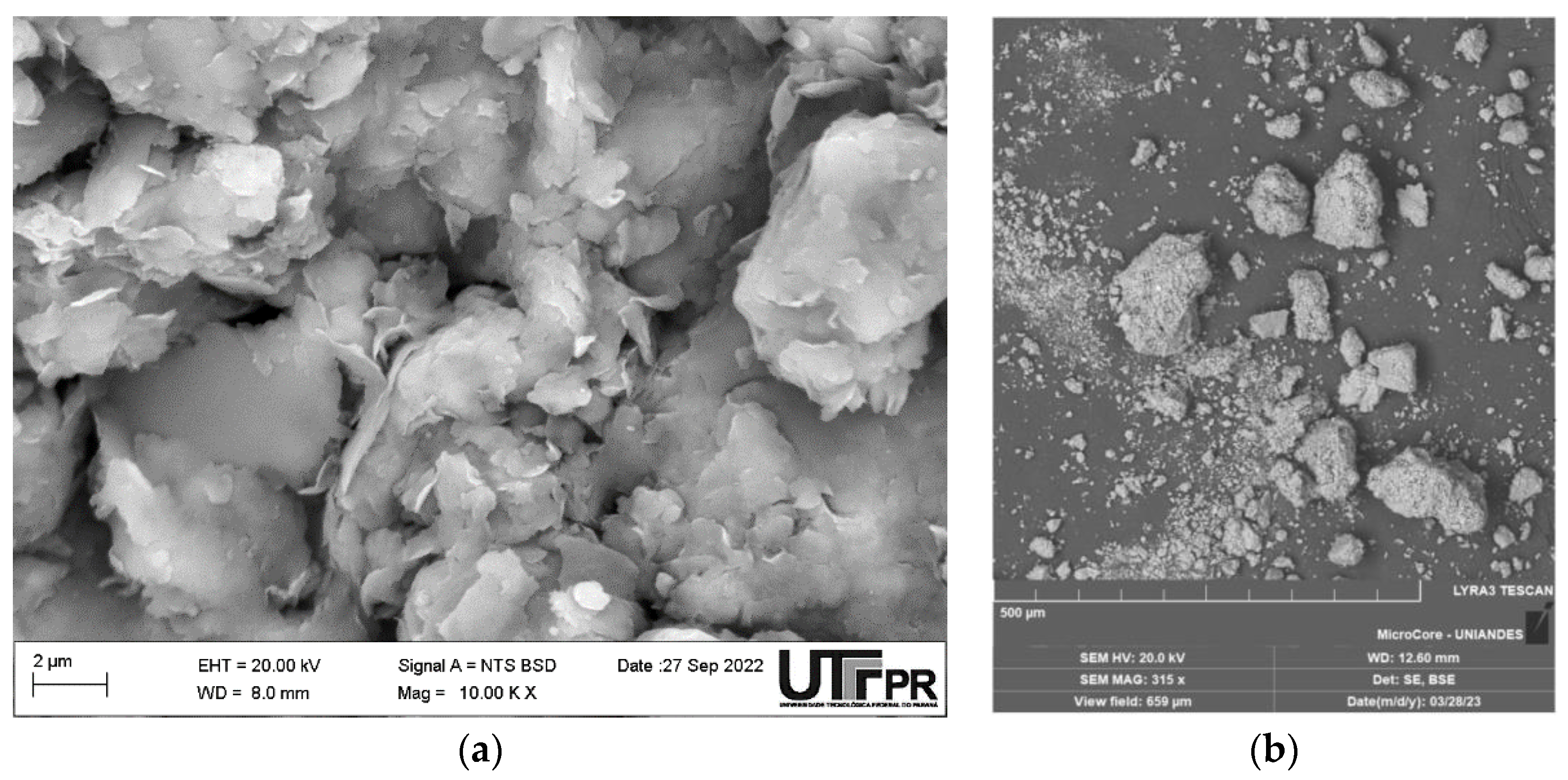
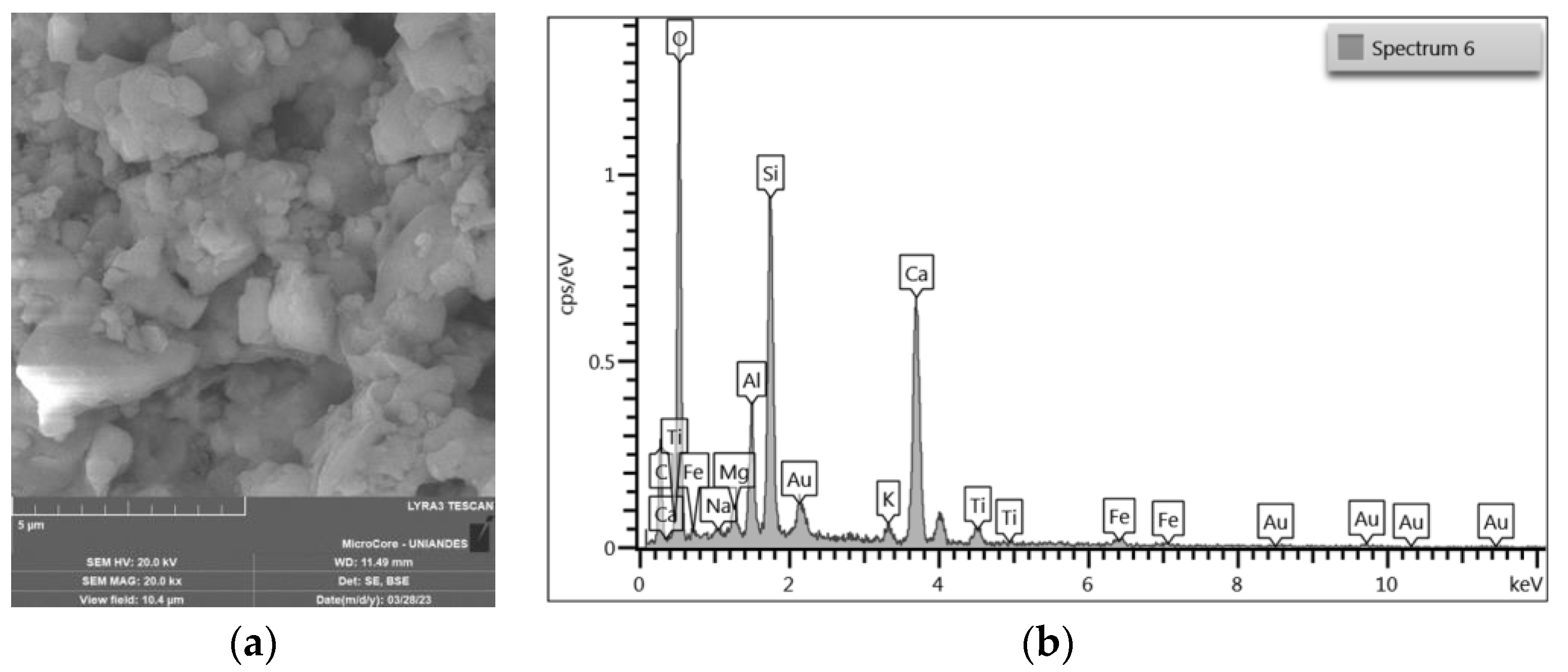

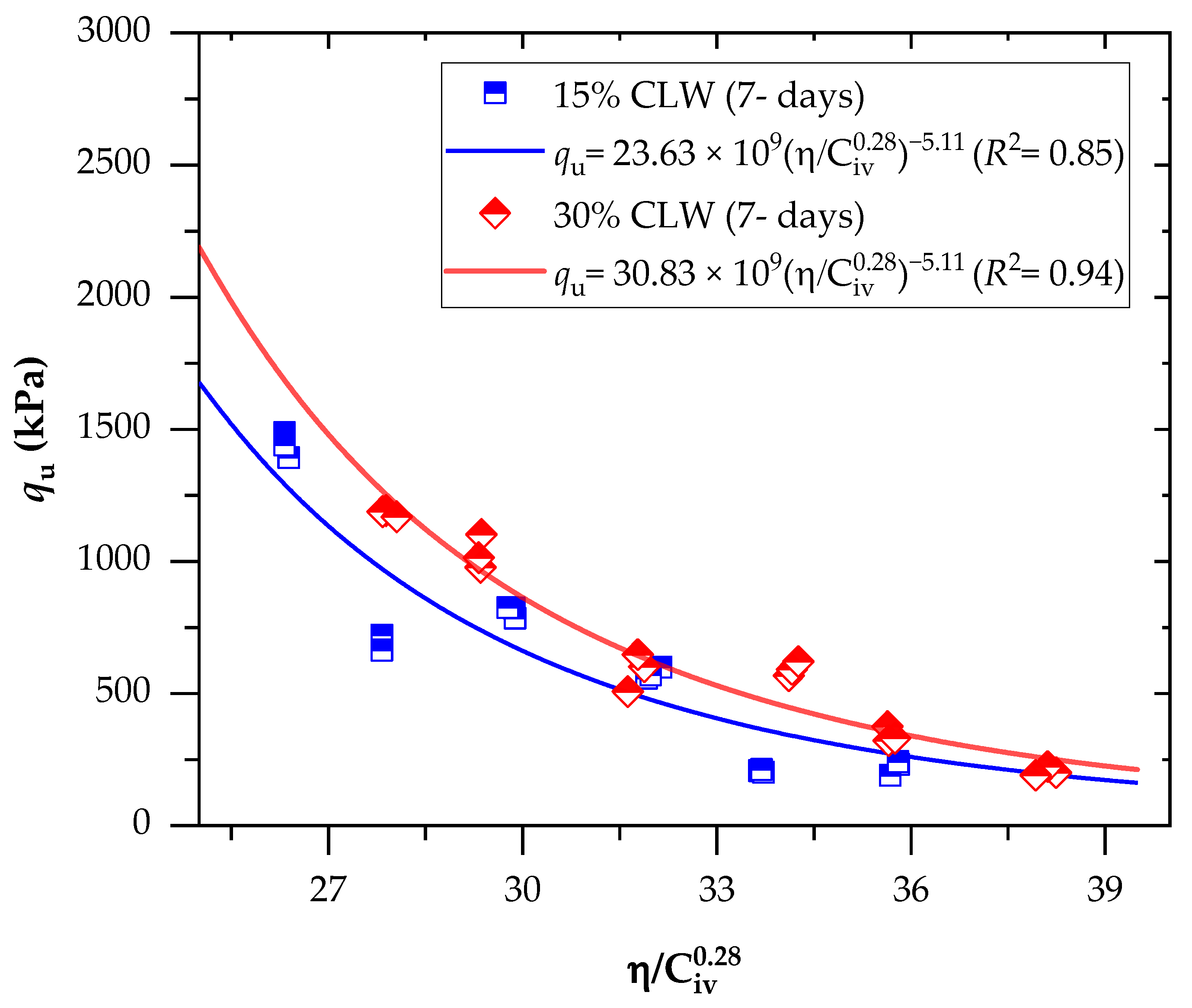


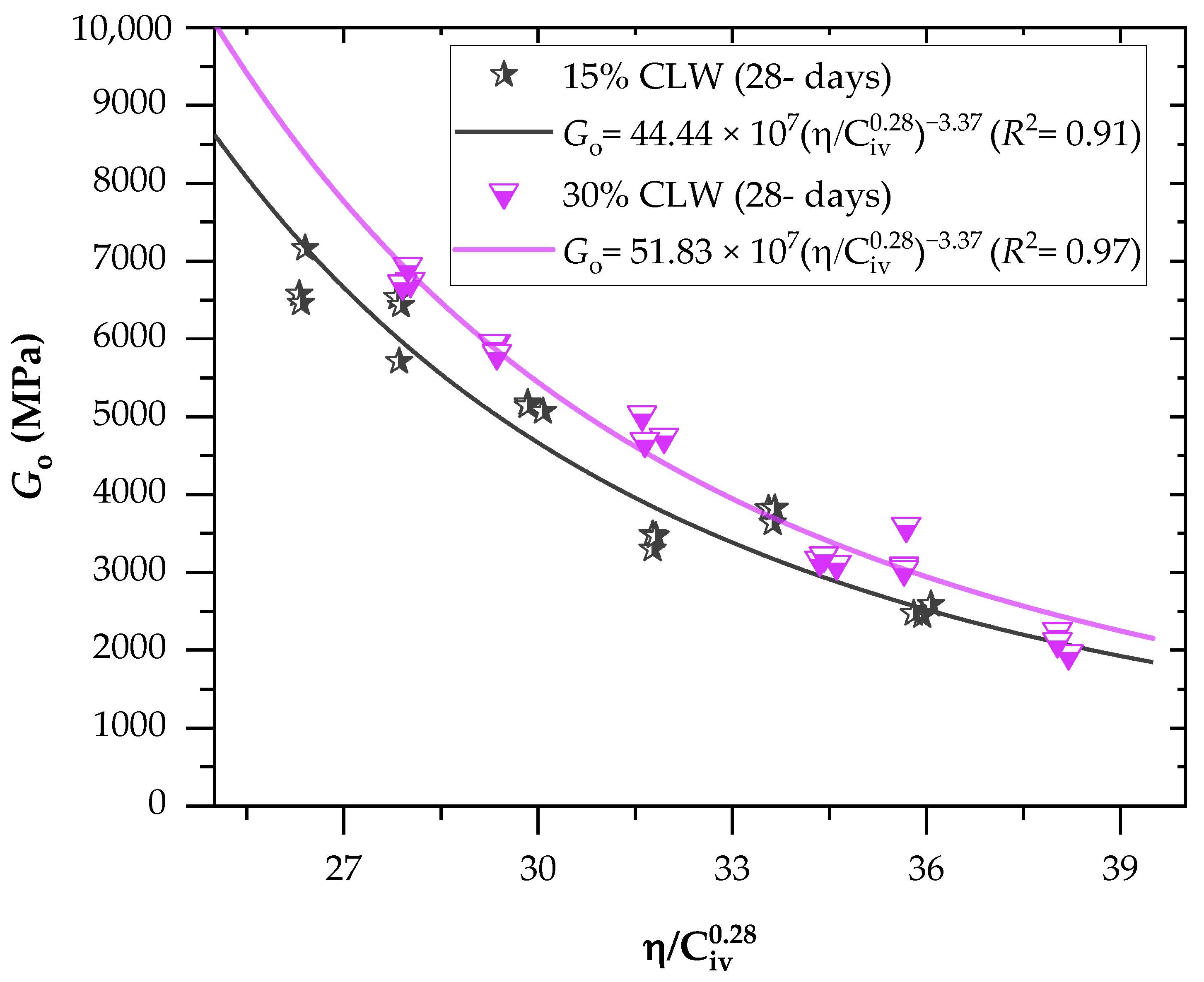

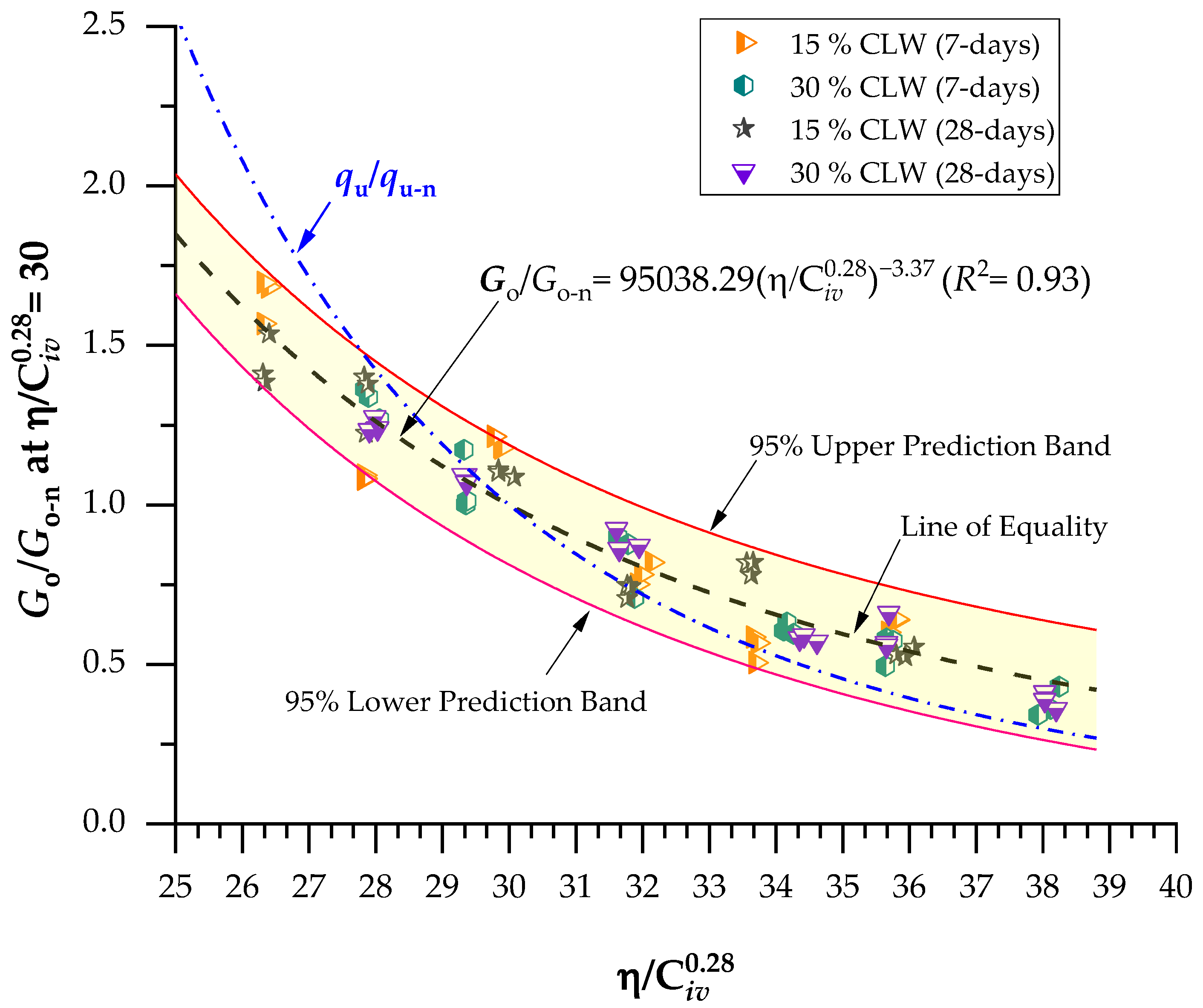
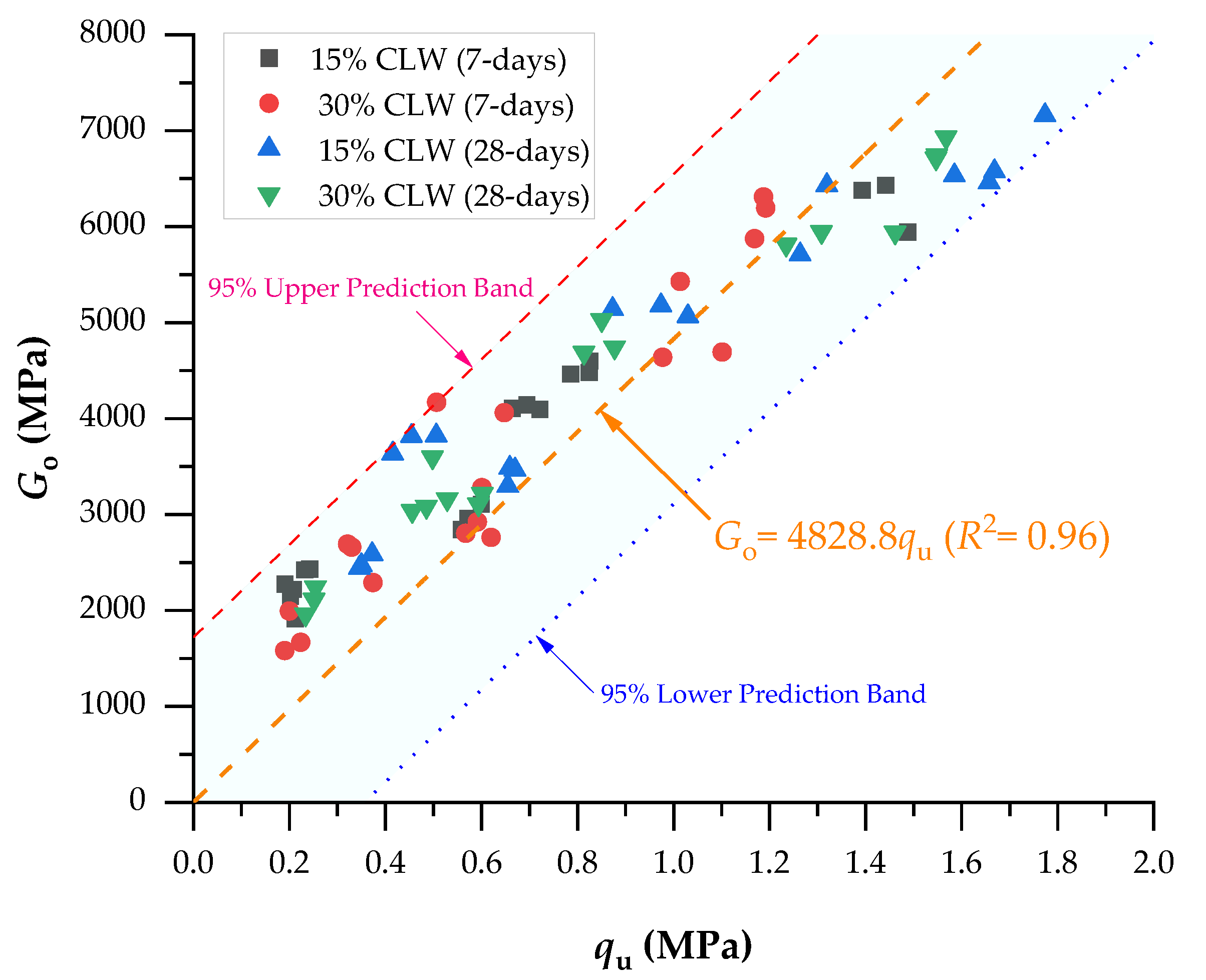


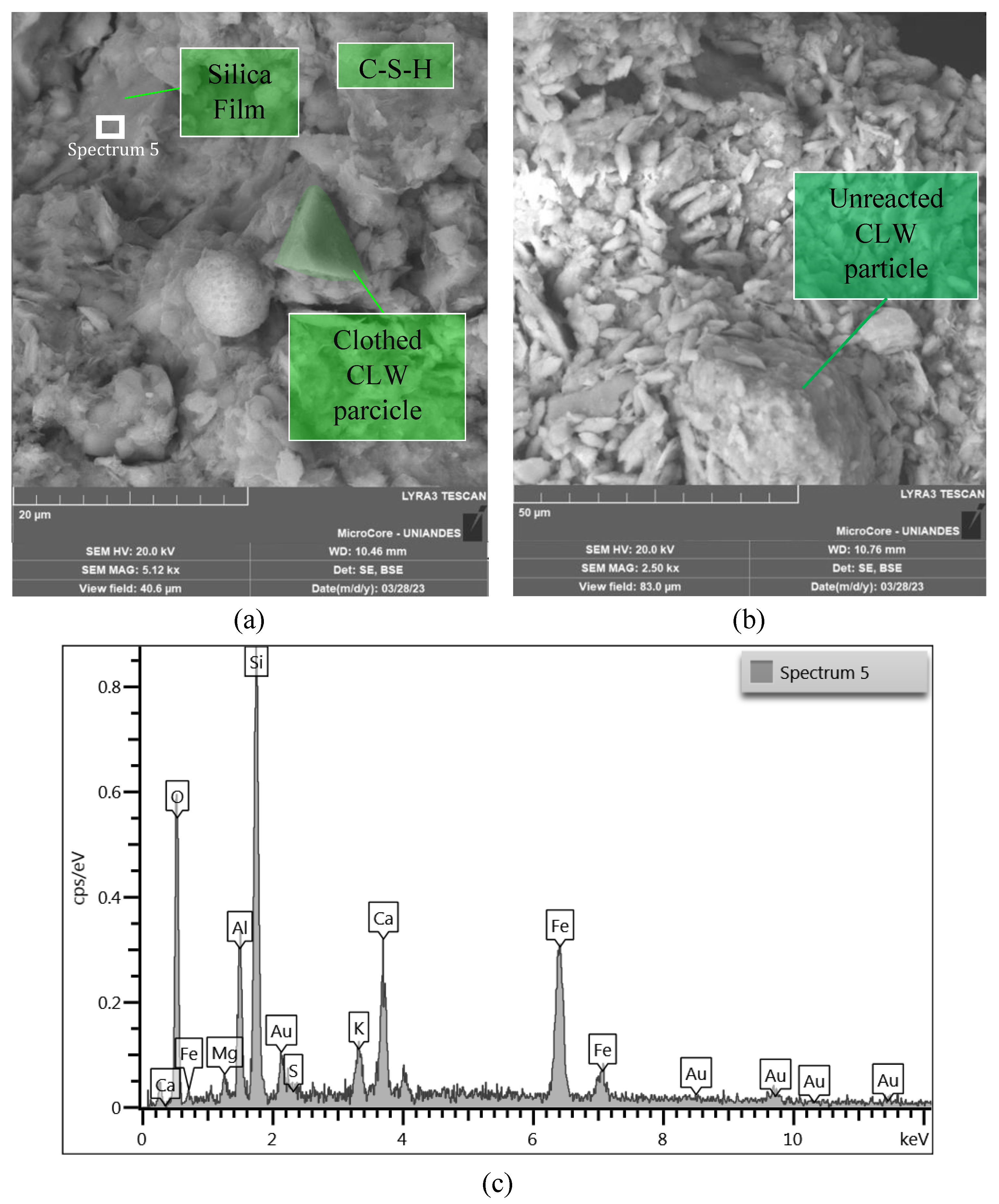
| Properties | Soil | CLW |
|---|---|---|
| LL Limit Liquid of soil, % | 42.00 | - |
| PL Plastic Limit of soil, % | 26.05 | - |
| PI Plastic Index of soil, %, (i.e., LL-PL) | 15.95 | - |
| Gravel particles (Ø-2 mm), % | 0 | 41 |
| Coarse sand particles size (0.6 mm-Ø-2 mm), % | 0 | 32 |
| Medium sand particles size (0.2 mm-Ø-0.6 mm), % | 0 | 13 |
| Fine sand particles size (0.06 mm-Ø-0.2 mm), % | 12 | 14 |
| Silt particles size (0.002 mm-Ø-0.06 mm), % | 78 | - |
| Clay particles size (Ø < 0.002 mm), % | 10 | - |
| Effective size of materials (D10), mm | 0.0021 | 0.15 |
| Mean particle diameter (D50), mm | 0.011 | 1.6 |
| Uniformity coefficient of materials (Cu) | 7.14 | 13.67 |
| Coefficient of curvature of materials (Cc) | 0.96 | 1.59 |
| The specific gravity of soil sample and CLW | 2.80 | 2.52 |
| Activity of clay, A [A = PI/(% < 0.002 mm)] | 1.60 | - |
| Color of marine of raw materials | Black | Gray |
| Classification of raw materials (USCS) | CL | SW |
| Element | Soil Composition (%) | CLW Composition (%) |
|---|---|---|
| SiO2 | 66 | 9.0 |
| Al2O3 | 21.7 | 1.3 |
| SO3 | 5.0 | - |
| K2O | 3.1 | - |
| CaO | 3.0 | 72.4 |
| Fe2O3 | 0.9 | 0.9 |
| TiO2 | 0.3 | - |
| MgO | - | 2.1 |
| Mn | - | 14.3 |
| Source | Sum of Squares | Degrees of Freedom | Mean Squares | Z | p-Value | Significance (p-Value < 0.05) |
|---|---|---|---|---|---|---|
| Cement (C) | 187,370.055 | 1 | 187,370.055 | 96.994 | <0.001 | yes |
| CLW | 200,929.215 | 1 | 200,929.215 | 104.013 | <0.001 | yes |
| γd | 2,296,409.103 | 7 | 328,058.443 | 169.822 | <0.001 | yes |
| Curing time (t) | 8856.464 | 1 | 8856.464 | 4.585 | 0.039 | yes |
| C * CLW | 398,023.336 | 1 | 398,023.336 | 206.040 | <0.001 | yes |
| C * γd | 2,259,401.699 | 3 | 753,133.900 | 389.866 | <0.001 | yes |
| C * t | 51,955.811 | 1 | 51,955.811 | 26.895 | <0.001 | yes |
| CLW * γd | 2,446,021.981 | 5 | 489,204.396 | 253.241 | <0.001 | yes |
| CLW * t | 161,796.778 | 1 | 161,796.778 | 83.756 | <0.001 | yes |
| γd * t | 369,913.213 | 5 | 73,982.643 | 38.298 | <0.001 | yes |
| Error | 75,339.212 | 39 | 1931.775 | |||
| Total | 57,151,136.704 | 72 |
| Source | Sum of Squares | Degrees of Freedom | Mean Squares | Z | p-Value | Significance (p-Value < 0.05) |
|---|---|---|---|---|---|---|
| Cement (C) | 52,075,561.361 | 1 | 52,075,561.361 | 746.458 | <0.000 | yes |
| CLW | 461,084.863 | 1 | 461,084.863 | 6.609 | <0.014 | yes |
| γd | 17,869,755.772 | 7 | 2,552,822.253 | 36.592 | <0.000 | yes |
| Tempo (t) | 5,291,448.551 | 1 | 5,291,448.551 | 75.848 | <0.000 | yes |
| C * CLW | 76,122.097 | 1 | 76,122.097 | 1.091 | 0.302 | no |
| C * γd | 2,278,178.994 | 3 | 759,392.998 | 10.885 | <0.000 | yes |
| C * t | 662,158.109 | 1 | 662,158.109 | 9.491 | <0.004 | yes |
| CLW * γd | 468,352.678 | 5 | 93,670.536 | 1.343 | 0.264 | no |
| CLW * t | 208,152.497 | 1 | 208,152.497 | 2.984 | <0.091 | no |
| γd * t | 3,357,848.111 | 5 | 671,569.622 | 9.626 | <0.000 | yes |
| Error | 3,139,360.982 | 45 | 69,763.577 | |||
| Total | 1,384,692,258.529 | 72 |
Disclaimer/Publisher’s Note: The statements, opinions and data contained in all publications are solely those of the individual author(s) and contributor(s) and not of MDPI and/or the editor(s). MDPI and/or the editor(s) disclaim responsibility for any injury to people or property resulting from any ideas, methods, instructions or products referred to in the content. |
© 2023 by the authors. Licensee MDPI, Basel, Switzerland. This article is an open access article distributed under the terms and conditions of the Creative Commons Attribution (CC BY) license (https://creativecommons.org/licenses/by/4.0/).
Share and Cite
Román Martínez, C.; Nuñez de la Rosa, Y.E.; Estrada Luna, D.; Baldovino, J.A.; Jordi Bruschi, G. Strength, Stiffness, and Microstructure of Stabilized Marine Clay-Crushed Limestone Waste Blends: Insight on Characterization through Porosity-to-Cement Index. Materials 2023, 16, 4983. https://doi.org/10.3390/ma16144983
Román Martínez C, Nuñez de la Rosa YE, Estrada Luna D, Baldovino JA, Jordi Bruschi G. Strength, Stiffness, and Microstructure of Stabilized Marine Clay-Crushed Limestone Waste Blends: Insight on Characterization through Porosity-to-Cement Index. Materials. 2023; 16(14):4983. https://doi.org/10.3390/ma16144983
Chicago/Turabian StyleRomán Martínez, Carlos, Yamid E. Nuñez de la Rosa, Daniela Estrada Luna, Jair Arrieta Baldovino, and Giovani Jordi Bruschi. 2023. "Strength, Stiffness, and Microstructure of Stabilized Marine Clay-Crushed Limestone Waste Blends: Insight on Characterization through Porosity-to-Cement Index" Materials 16, no. 14: 4983. https://doi.org/10.3390/ma16144983
APA StyleRomán Martínez, C., Nuñez de la Rosa, Y. E., Estrada Luna, D., Baldovino, J. A., & Jordi Bruschi, G. (2023). Strength, Stiffness, and Microstructure of Stabilized Marine Clay-Crushed Limestone Waste Blends: Insight on Characterization through Porosity-to-Cement Index. Materials, 16(14), 4983. https://doi.org/10.3390/ma16144983







